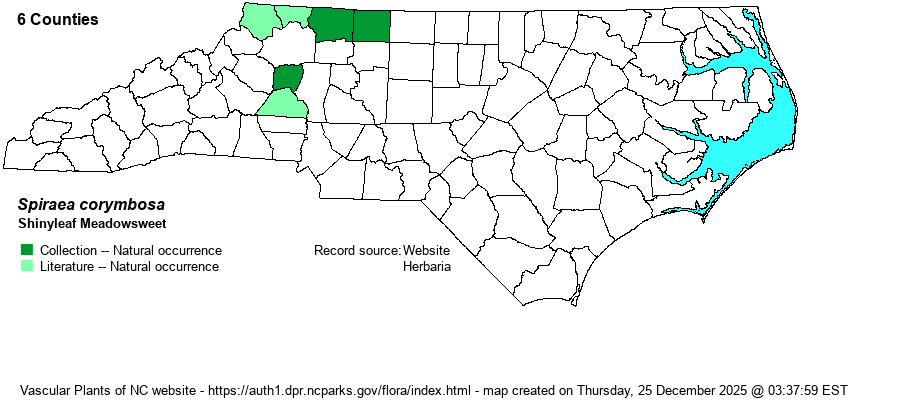| Author | Rafinesque | |
| Distribution | Restricted essentially to the northwestern Piedmont monadnocks and foothills, and the extreme northern Mountains. The southern end of the species’ range is Catawba County. A specimen from Burke County is S. japonica. The Surry County record (USDA) is not supported by a specimen at SERNEC.
This species has a very small and narrow range, being restricted to the central Appalachians and nearby Piedmont, from southern PA only to west-central NC. It is by far most widespread in VA, where there are more county records than in all other counties combined elsewhere in the range.
| |
| Abundance | Rare, and restricted to localized upland forests on rock outcrops. This is a State Endangered species. | |
| Habitat | In NC, it is almost entirely restricted to dry, upland forests on Piedmont monadnocks, but it may occur along forested edges of such outcrops. It may rarely occur along stream banks, probably where rocky, though this is likely only in VA. | |
| Phenology | Blooms from June to August, and fruits from August to October. | |
| Identification | Unlike other Spiraea species, this is a low shrub, mainly growing to just 3 feet tall, usually only about 1-1.5 feet tall. This deciduous shrub usually grows in colonies, though it is not clonal. It is generally unbranched or sparsely so. The leaves, which are really not shiny, are quite wide for this genus, being widely elliptic, with doubly serrate margins on the outer half of each leaf, growing to about 2 inches long. If in bloom -– with its 2-4-inch-wide flat cluster of small white flowers terminating the stems -- it becomes easy to spot and identify; the inflorescence looks top-heavy, as if too large for the size of the plant. However, as it is a rare species and restricted to rocky woodlands, you are not likely to stumble onto this species, particularly in bloom. | |
| Taxonomic Comments | This taxon was formerly included within the widespread Spiraea betulifolia, but Weakley (2018) and many others consider the southern Appalachian form/taxon to be a valid species, as S. corymbosa. NatureServe Explorer still considers the NC taxon as a variety, as S. betulifolia var. corymbosa. As our website follows the taxonomy of Weakley (2018), we must provide a new global rank for a full species (and thus no “T” in the rank). The NatureServe’s global rank of G5T4? for the variety now becomes G4?Q for the full species, and it is listed in brackets to let the reader know this is not the Nature Serve rank.
| |
| Other Common Name(s) | Dwarf Spiraea is often used, and is probably a more descriptive common name than is Shinyleaf Meadowsweet. Rock Spiraea is another common name. | |
| State Rank | S1 | |
| Global Rank | G5T4? [G4?] | |
| State Status | E | |
| US Status | | |
| USACE-agcp | | |
| USACE-emp | | |

